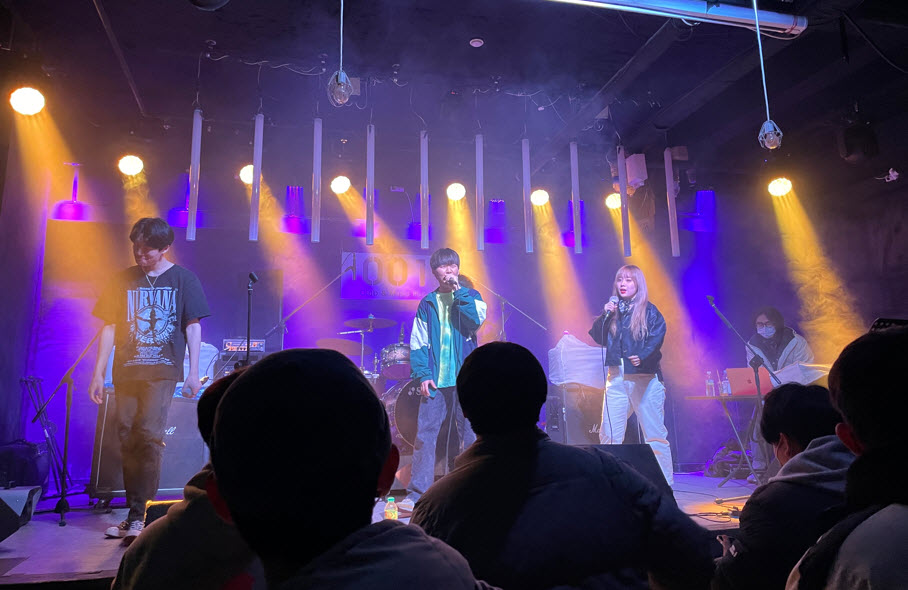
According to poet Henry Wadsworth Longfellow, music is the “universal language” of humankind. At SNU, it seems there are many students who speak this language, both fluently and passionately. Bounce Factory is one prominent group of such students. Bounce Factory is a hip-hop club composed of SNU students of all departments and colleges, in which members write, produce, perform and sometimes even release their own music. Since 2001, it has served as a site of work, play, and challenge for the musicians of SNU.
On November 25, Bounce Factory returned with its annual concert, after a hiatus last year due to the pandemic. Held in a performance club at Hongdae, this year’s concert was named “RE:BORN” to acknowledge the impact of the past two years. Going through a tough time as a performance-based club, Bounce Factory experienced several changes not only in its primary activities and members, but also in its overall direction. The show consisted of two parts, with performances from both club members and guest appearances. Seats were limited and pre-reserved, and unlike typical hip-hop concerts, COVID-19 guidelines required audiences to stay seated at all times. Such restrictions did not, however, seem to lessen the hype and enjoyment of the crowd in any way. The concert ended successfully with bursts of applause from a very excited audience, facing a stage of beaming performers.
Yoo Jin-Il, the current president of the club, spoke about the hardships that the students faced in planning this year’s concert. Nervous about staging a live show after such a long break, auditions were held among members, and Yoo contacted and cast personal acquaintances to perform as guests. “We really gave our best this year,” he said confidently.

Bounce Factory is one of many clubs in SNU that provide opportunities to students with diverse artistic, athletic, or academic interests. Any student member of SNU is free to join without auditions. As of 2021, there are about 60 members, larger than the average university hip-hop club. In addition to singers and rappers, producers or sound engineers make up the membership for the group.
These talents of the club are recognized both within SNU and beyond. Many people know Bounce Factory from its participation in “Sudojeon”, a competition between SNU and Hanyang University every year. The battle between the two universities’ two hip-hop clubs is broadcasted on Wonderwood, a YouTube channel devoted to college hip-hop. This year marks the fourth season of the event, and Bounce Factory participated with its song and music video, “Curtain Call.” Since its first season, the event has evolved from a playful banter between the two universities to a true manifestation of each school’s respective spirit.
The corridors of SNU’s Student Center are filled with traces of student clubs and activities. Bounce Factory designed its allotted space, room 303, as a studio workspace. Some members, including Yoo, even have their own private studios outside of campus. He discussed the difficulties of balancing his musical hobbies and classwork. On many occasions, practices and recordings overlap with exams or assignments. Keeping this balance is one of the most important lessons that members learn during their time in Bounce Factory. “On the one hand, we’re seen as students who don’t do what we’re supposed to do – which is to study. Then on the other hand, many people automatically assume that academically driven students don’t have what it takes to make music,” said Yoo. “But I have yet to see any group of people who are as passionate about both their academic field and their artistic interests as our members. We challenge these prejudices because we want SNU students to be acknowledged for their versatile talents and passions.”
Bounce Factory is looking forward to holding another concert at the beginning of the new year, with all members’ participation. It will continue, along with many other colorful student activities and clubs, to enrich students’ experiences, memories and passions at SNU.
Written by Minjoo Lee, SNU English Editor, mjl1018@snu.ac.kr
Reviewed by Professor Travis Smith, Department of Asian Languages and Civilizations, tlsmith@snu.ac.kr

